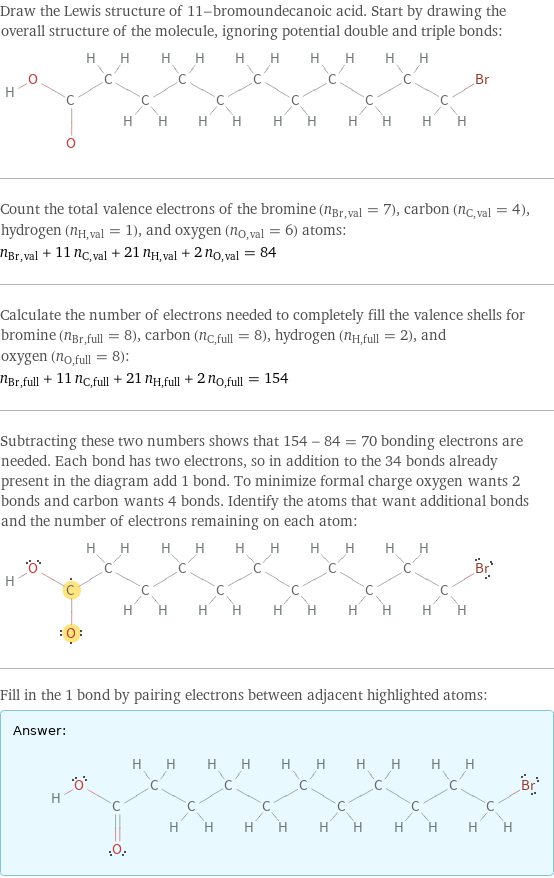Input interpretation

11-bromoundecanoic acid
Chemical names and formulas

formula | Br(CH_2)_10COOH Hill formula | C_11H_21BrO_2 name | 11-bromoundecanoic acid mass fractions | Br (bromine) 30.1% | C (carbon) 49.8% | H (hydrogen) 7.98% | O (oxygen) 12.1%
Lewis structure

Draw the Lewis structure of 11-bromoundecanoic acid. Start by drawing the overall structure of the molecule, ignoring potential double and triple bonds: Count the total valence electrons of the bromine (n_Br, val = 7), carbon (n_C, val = 4), hydrogen (n_H, val = 1), and oxygen (n_O, val = 6) atoms: n_Br, val + 11 n_C, val + 21 n_H, val + 2 n_O, val = 84 Calculate the number of electrons needed to completely fill the valence shells for bromine (n_Br, full = 8), carbon (n_C, full = 8), hydrogen (n_H, full = 2), and oxygen (n_O, full = 8): n_Br, full + 11 n_C, full + 21 n_H, full + 2 n_O, full = 154 Subtracting these two numbers shows that 154 - 84 = 70 bonding electrons are needed. Each bond has two electrons, so in addition to the 34 bonds already present in the diagram add 1 bond. To minimize formal charge oxygen wants 2 bonds and carbon wants 4 bonds. Identify the atoms that want additional bonds and the number of electrons remaining on each atom: Fill in the 1 bond by pairing electrons between adjacent highlighted atoms: Answer: | |
3D structure

3D structure
Basic properties

molar mass | 265.19 g/mol phase | solid (at STP) melting point | 46.5 °C boiling point | 173.5 °C (measured at 266.6 Pa)
Units

Thermodynamic properties

molar heat of vaporization | 65.8 kJ/mol specific heat of vaporization | 0.2481 kJ/g (at STP)
Chemical identifiers

CAS number | 2834-05-1 Beilstein number | 1767205 PubChem CID number | 17812 PubChem SID number | 24850148 SMILES identifier | C(CCCCCBr)CCCCC(=O)O InChI identifier | InChI=1/C11H21BrO2/c12-10-8-6-4-2-1-3-5-7-9-11(13)14/h1-10H2, (H, 13, 14)/f/h13H MDL number | MFCD00002732
Safety properties

flash point | 110 °C